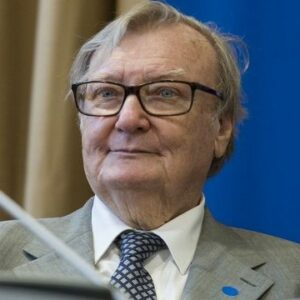Carlo Rubbia is an Italian physicist. For many years, he has been one of the most important people in the field of particle physics. In 1984, he shared the Nobel Prize in Physics for his outstanding work showing that W and Z particles, or bosons, exist. His father was an electrical engineer, and when he first started high school, he was very interested in science, especially engineering and mechanical theories. But when the Second World War started, it hurt his education a lot, and he couldn’t get into the university he wanted to go to, Scuola Normale in Pisa. But he was given a place to study there after a year. After getting his Ph.D. from the University of Pisa, he did more research at Columbia University. After some time in the U.S., he joined CERN in Geneva, Switzerland. Most of his important work was done at CERN, and he later became the Director-General of the CERN Laboratory. He has also taught physics at Harvard University and, because of his reputation in the scientific community, he continues to serve in a number of scientific advisory roles.
Early years and childhood
Carlo Rubbia was born in Gorizia, Friuli-Venezia Giulia, Italy, on March 31, 1934. His parents were Silvio Rubbia and his wife, Bice. His father worked as an electrical engineer for the local phone company, and his mother taught in an elementary school.
He has always been good at and interested in science. He was especially interested in mechanics and engineering. His high school education was affected by the Second World War, and by the time he graduated, he had forgotten what he had learned.
He had wanted to go to the Scuola Normale in Pisa to study physics, but instead, he went to the University of Milan to study engineering. But after a few months, he was invited to join Scuola Normale. He did a series of experiments on cosmic rays and graduated in 1957. The University of Pisa gave him his doctorate the year after that.
Carlo Rubbia’s Career
After getting his Ph.D., he moved to the US and did his post-Ph.D. research at the well-known Columbia University. At Columbia University, he and W. Baker worked on the angular symmetry that can be seen when polarized muons are captured. His work as a scientist would be shaped by these experiments.
After spending 1.5 years at Columbia University, he went back to Europe in 1960 to continue his research on weak interaction structures at the European Organisation of Nuclear Research (CERN). He made a lot of progress in his field of study because the Syncro-cyclotron at CERN was much better than the ones he had used before.
After Val Fitch and James Cronin found CP Violation in 1964, Rubbia decided to stop all of his research and look into where CP Violation came from. But the research didn’t lead anywhere, so he went back to studying weak interactions. In 1970, Harvard University hired him as a professor of physics. For the next 18 years, he taught one semester at Harvard and spent the rest of the year at CERN.
In 1973, he worked with a group of scientists on a series of experiments that led to the postulates of the electroweak theory, which are things that can be seen in weak, neutral currents.
In 1976, he asked CERN to build the Super Proton Synchrotron, and it began to work in 1981. Two years later, he helped a group of scientists does experiments on the colliding beam machine. These experiments proved the existence of W and Z particles or bosons, which led to a lot of future nuclear research. He and another scientist, Simon van der Meer, both got the Nobel Prize in Physics for their work.
In 1989, he became the Director-General of the CERN Laboratory. One of his most important contributions was making it possible for anyone to use the web protocol and the lab’s code for free. He worked with the Gran Sasso laboratory in his home country of Italy to do tests on how to find decaying protons.
In 1995, he was named president of ENEA, which is the Italian National Agency for New Technologies, Energy, and Sustainable Economic Development. During his six years as president, he worked on a new way to concentrate solar power. He joined EU President Barroso’s group of advisors on climate change two years after he left ENEA.
In 2009, the Secretary-General of the United Nations Economic Commission for Latin America made him a special advisor. He worked on the job for a year in Chile. After that, the Institute of Advanced Sustainability Studies in Potsdam, Germany, hired him as the Scientific Director.
Works of note
Together with Simon van der Meer, he did a series of experiments that proved the existence of W and Z particles or bosons. This was his most important work. In 1984, he was given a share of the Nobel Prize in Physics for his work.
Awards & Achievements
In 1984, he shared the Nobel Prize for Physics.
In 1985, he became a member of the Royal Society.
In 1989, he got the “Dirac Medal.”
In 2013, Giorgio Napolitano, who was president of Italy at the time, made him a Senator for Life in the Italian Senate.
Personal History and Legacies
He got married to Marisa, who taught physics, but no one knows the exact date. Laura, their daughter, and Andre, their son, are their children.
Estimated Net worth
Carlo Rubbia is one of the wealthiest and most well-known physicists. Carlo Rubbia’s net worth is about $3 million, according to our research, Wikipedia, Forbes, and Business Insider.


